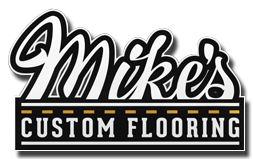Glue down hardwood floor installation is a popular method of installing hardwood floors. This type of installation involves applying an adhesive to the subfloor before laying the hardwood planks. Once the adhesive dries, the planks are firmly attached to the subfloor, resulting in a durable and long-lasting floor. With this in mind, we at Mike’s Custom Flooring would like to share the basics of glued down hardwood floor installation.
How Long Does it Take to Install Glue Down Flooring?
1) Hardwood Floor Preparation: Before installing the hardwood floor, it is essential to prepare the subfloor properly. The subfloor should be clean, dry, level, and free of any debris or dust. If the subfloor is not level, it should be sanded down, and any high spots should be filled in with a leveling compound.
2) Hardwood Flooring Acclimation: The hardwood planks should be acclimated to the room’s temperature and humidity for at least 48 hours before installation. This will help prevent the planks from expanding or contracting after installation.
3) Adhesive Selection: The right adhesive is crucial for a successful installation. There are two types of adhesives commonly used for hardwood floor installation: moisture-cured urethane and MS polymer. The choice of adhesive depends on the subfloor’s material, the type of hardwood planks, and the room’s humidity levels.
4) Adhesive Application: The adhesive is typically applied to the subfloor using a notched trowel. The notches in the trowel help spread the adhesive evenly and create a solid bond between the subfloor and the hardwood planks.
5) Plank Installation: Once the adhesive is applied, the hardwood planks are placed on the subfloor and firmly pressed down to ensure a strong bond. It is essential to stagger the planks for a natural look and to ensure a strong and stable floor.
6) Hardwood Floor Finishing: After the hardwood floor is installed, it is essential to let the adhesive dry completely before applying any finishing products. Once the adhesive is dry, the floor can be sanded, stained, and sealed to protect it from moisture and wear.
Considerations for Glue Down Hardwood Flooring
It is important to note that glued down hardwood floor installation is not recommended for all subfloors. For example, it is not suitable for subfloors that are prone to moisture, such as concrete or basements. In these cases, floating or nail-down installation methods may be more appropriate. Additionally, it is important to choose the right type of hardwood flooring for a glued down installation. Engineered hardwood is often the preferred choice because it is more stable and less prone to warping than solid hardwood. It is also important to choose a hardwood species that is compatible with the adhesive being used.
Hardwood Floor Installation, Repairs, Refinishing & More in Charles Town & Eastern Panhandle of Berkeley & Jefferson Counties in WV | Winchester & Frederick County | Round Hill & Loudoun County | Berryville & Clarke County | Herndon & Fairfax County VA
Glued down hardwood floor installation can be a great option for homeowners looking for a durable and long-lasting hardwood floor. By properly preparing the subfloor, choosing the right adhesive, and installing the planks correctly, homeowners can enjoy a beautiful and reliable hardwood floor for years to come. The glue down hardwood floor installation is an excellent option for homeowners who want a durable, long-lasting, and attractive floor. While it may require a bit more effort and preparation than other installation methods, the results are well worth the effort. By following the basics outlined above, homeowners can ensure a successful installation that will stand the test of time. If you are interested in glue down hardwood floor installation, call Mike’s Custom Flooring and let us ensure long-lasting, premium results.





